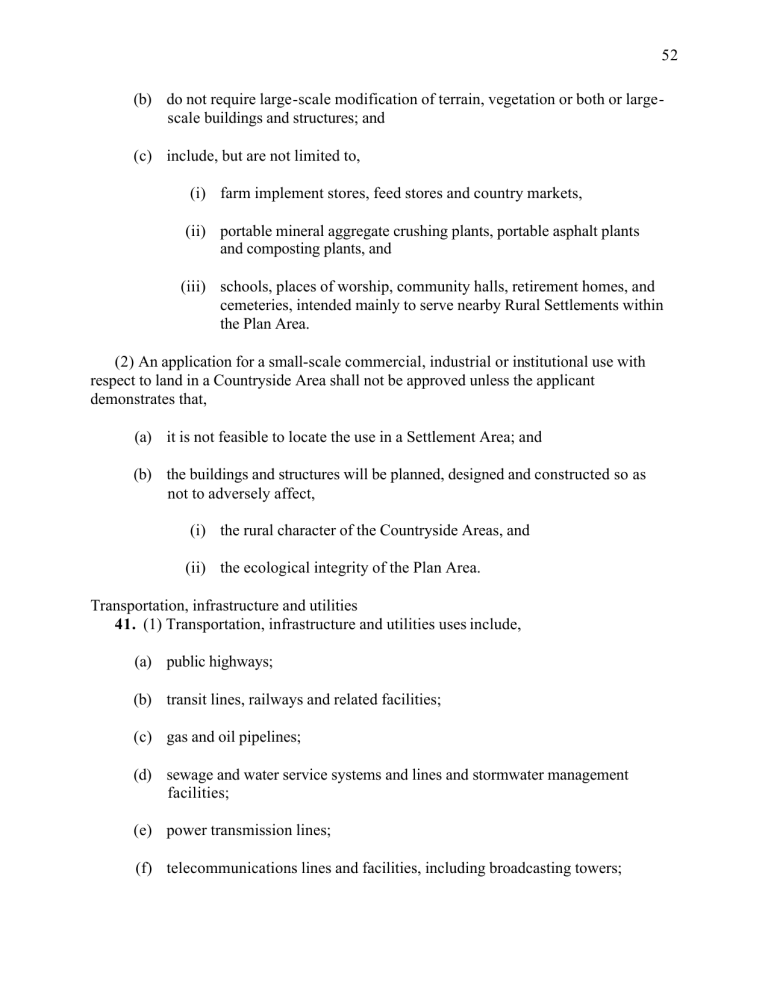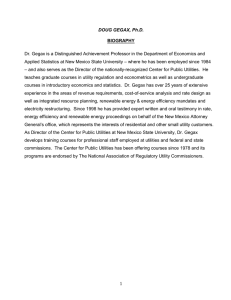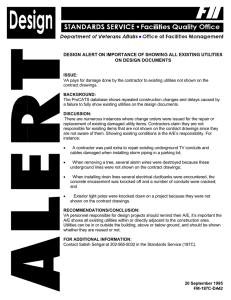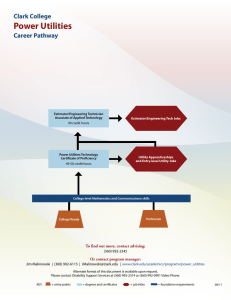52 (b) do not require large-scale modification of terrain, vegetation... (c) include, but are not limited to,

(b) do not require large-scale modification of terrain, vegetation or both or largescale buildings and structures; and
(c) include, but are not limited to,
(i) farm implement stores, feed stores and country markets,
(ii) portable mineral aggregate crushing plants, portable asphalt plants and composting plants, and
(iii) schools, places of worship, community halls, retirement homes, and cemeteries, intended mainly to serve nearby Rural Settlements within the Plan Area.
(2) An application for a small-scale commercial, industrial or institutional use with respect to land in a Countryside Area shall not be approved unless the applicant demonstrates that,
(a) it is not feasible to locate the use in a Settlement Area; and
(b) the buildings and structures will be planned, designed and constructed so as not to adversely affect,
(i) the rural character of the Countryside Areas, and
(ii) the ecological integrity of the Plan Area.
Transportation, infrastructure and utilities
41.
(1) Transportation, infrastructure and utilities uses include,
(a) public highways;
(b) transit lines, railways and related facilities;
(c) gas and oil pipelines;
(d) sewage and water service systems and lines and stormwater management facilities;
(e) power transmission lines;
(f) telecommunications lines and facilities, including broadcasting towers;
52
53
(g) bridges, interchanges, stations, and other structures, above and below ground, that are required for the construction, operation or use of the facilities listed in clauses (a) to (f); and
(h) rights of way required for the facilities listed in clauses (a) to (g).
(2) An application for a transportation, infrastructure or utilities use with respect to land in a Natural Linkage Area shall not be approved unless,
(a) the need for the project has been demonstrated and there is no reasonable alternative; and
(b) the applicant demonstrates that the following requirements will be satisfied, to the extent that is possible while also meeting all applicable safety standards:
1. The area of construction disturbance will be kept to a minimum.
2. Right of way widths will be kept to the minimum that is consistent with meeting other objectives such as stormwater management and with locating as many transportation, infrastructure, and utility uses within a single corridor as possible.
3. The project will allow for wildlife movement.
4. Lighting will be focused downwards and away from Natural Core
Areas.
5. The planning, design and construction practices adopted will keep any adverse effects on the ecological integrity of the Plan Area to a minimum.
(3) An application for a transportation, infrastructure or utilities use with respect to land in a Natural Core Area shall not be approved unless the applicant demonstrates that,
(a) the requirements of subsection (2) have been met;
(b) the project does not include and will not in the future require a highway interchange or a transit or railway station in a Natural Core Area; and
(c) the project is located as close to the edge of the Natural Core Area as possible.
54
(4) Except as permitted in subsection (5), with respect to land in a key natural heritage feature or a hydrologically sensitive feature, all new transportation, infrastructure and utilities uses and all upgrading or extension of existing transportation, infrastructure and utilities uses, including the opening of a road within an unopened road allowance, are prohibited.
(5) Transportation, infrastructure, and utilities uses may be permitted to cross a key natural heritage feature or a hydrologically sensitive feature if the applicant demonstrates that,
(a) the need for the project has been demonstrated and there is no reasonable alternative;
(b) the planning, design and construction practices adopted will keep any adverse effects on the ecological integrity of the Plan Area to a minimum;
(c) the design practices adopted will maintain, and where possible improve or restore, key ecological and recreational linkages, including the trail system referred to in section 39;
(d) the landscape design will be adapted to the circumstances of the site and use native plant species as much as possible, especially along rights of way; and
(e) the long-term landscape management approaches adopted will maintain, and where possible improve or restore, the health, diversity, size and connectivity of the key natural heritage feature or hydrologically sensitive feature.
(6) Service and utility trenches for transportation, infrastructure and utilities shall be planned, designed and constructed so as to keep disruption of the natural groundwater flow to a minimum.
Official plan provisions, wellhead protection areas, areas of high aquifer vulnerability
42. (1) Every official plan shall contain policies that,
(a) establish wellhead protection areas, in accordance with subsection (2), around all existing and new wells for municipal water services;
(b) with respect to each wellhead protection area,
(i) prohibit or restrict the uses listed in subsections 28 (1) and (2), and
(ii) prohibit or restrict other uses that could adversely affect the quality or quantity of groundwater reaching a well; and




